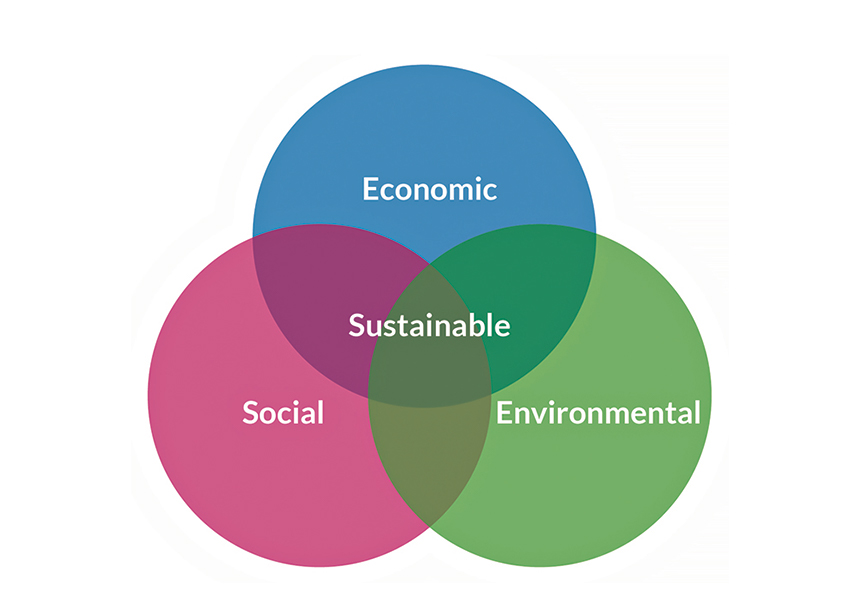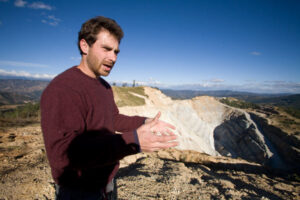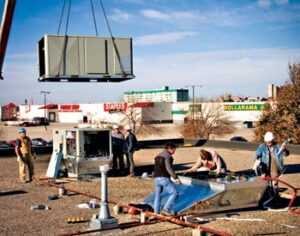Every time you walk into the church building, that threadbare carpet stares up at you. Everyone agrees it’s time for a change, but how do you replace a worn-out carpet without destroying the planet?
In the age of environmental awareness even a flooring choice goes well beyond a discussion of colour and price. Is the only option a new batch of carbon-intensive and off-gassing nylon, polypropylene and glue? What about sending all that non-recyclable material to the landfill?
As faith communities seek to live faithfully into the future, how do you factor creation care into your decisions?
For decades we have known that our choices damage the environment. For more than 40 years Mennonites have been making statements recognizing God’s call to care for creation, and yet we struggle to change our trajectory. (See sidebar below.)
Climate change, plastic waste, loss of biodiversity—the list of issues is daunting, and continues to grow. It’s as if we are on a ship heading straight for the rocks in spite of warning buoys, lighthouses or even the jagged shoreline looming ahead. Individual efforts seem insignificant, a choice between rearranging the deck chairs on the Titanic and trying to turn the ship with our bare hands.
Often we find ourselves stuck between options that seem either too little to matter or too much to take on. However, there is a viable choice between tokenism and “overwhelmism.” There are ways to more fully live out our call to care for God’s creation.
We begin moving towards a more sustainable way of living when we recognize that economics cannot be separated from environmental and social well-being.
Joanne Moyer is a professor at the King’s University in Edmonton and a long-time member of the Mennonite Creation Care Network. She defines sustainability as “promoting the flourishing of social-ecological systems and the individuals and communities within them.” Economic benefit must be considered together with environmental and societal health if we are to meet our needs without jeopardizing the future of our children and grandchildren.
Increasingly, societal and business leaders are realizing that not only is movement towards a sustainable future possible, it leads to better outcomes for profits as well as people and the planet. The rudder of the ship can be turned, and we are better for it. Many companies have realized that they can be financially viable while reducing—or even eliminating—negative effects on the environment. Some have found “green” alternatives that outperformed the original options. Others have recognized that without a healthy environment and social systems, they have no future in spite of short-term profits and gains.
How might we as people of faith “help move the rudder” to a more sustainable future? Following are some suggestions for strengthening our witness to the healing and hope we see in Christ, for each other and for all of creation.
Re-affirm our commitment to care for creation
Mennonite faith emphasizes combining faith and action. The creation story in Genesis 1 tells how God made a world that brought forth life in abundance and how the Creator pronounced it “very good.” Ensuring that God’s world continues to bring forth life in all its kinds is a central component of our faith calling.
It feels difficult to take action to prevent deforestation, overfishing and even climate change when we’re faced with the real prospect of lost jobs. As society shifts to that sweet spot where environmental, social and economic sustainability intersect, we need to find ways to bear the cost of the transition together.
At the same time, environmental degradation has a profound effect on vulnerable people. The Millennium Ecosystem Assessment, published in 2005, found that harm to the environment had the most impact on those who are poor, resulting in growing inequality, increasing poverty and social conflict.
Matthew 25 has served as a guide for how to treat those in need, calling us to give food to those who hunger and something to wear to those in need. Is it possible for us to see creation care as showing love for the vulnerable, whether it be those being impacted today or for generations to come? Is it possible for us to see Christ in the faces of those who say, “Rising sea levels caused by climate change are flooding my land, and you did nothing to stop it”?
Consider costs beyond the financial bottom line
When my family installed a solar-power array on our roof, a common question was, “How long will that take to pay for itself?” While our array will take years to pay for itself, our primary motivation was reducing our carbon footprint. The fact that we may come out financially ahead made the decision a no-brainer.
Our economic system often excludes the costs of emissions or other negative effects on people and our planet. Efforts to place a dollar figure on these impacts is one way policy-makers address this problem. For example, Environment and Climate Change Canada has estimated the costs of adapting to rising sea levels, drought and other climate-change effects. Its experts calculate that these costs could exceed $167 for every tonne of CO2 we emit. Cost estimates such as these make it possible to calculate a “social return on investment.” This approach seeks to factor in social and environmental costs and benefits that are otherwise ignored when making financial decisions.
Many businesses are beginning to think about the full life-cycle impact of their products. This includes the impact of manufacturing, use and disposal. Much of our consumption-based economy is structured on a cradle-to-grave model: resources are extracted from the environment, made into something, used and then disposed of in landfill. A more sustainable approach is known as “cradle-to-cradle,” in which used items provide the raw material for new ones. Often small design changes can result in a fully recyclable product.
Factoring in impacts beyond the bottom line is not new to Mennonite circles. Past initiatives such as Ten Thousand Villages helped create the fair-trade movement by providing producers with a fair wage. Caring for creation means choosing products with their full life-cycle impacts in mind, whether it be the clothes we wear or the flooring we choose.
Adding environmental factors to our purchasing decisions may seem daunting. As consumers we can choose to support companies that are clearly making efforts to become more sustainable.
One business leading the way is Interface, a carpet and flooring company. It recently achieved its goal of eliminating its harmful emissions. The company has now set its sights on creating products with net environmental and social benefits, including products that store more carbon than they emit over the course of their life-cycle.
Would we be willing to seek out companies like this when we replace the carpet at church? Would we be willing to be part of the movement to more sustainable purchasing choices?
Develop an action plan to help ‘turn the ship around’
As part of a broader faith-based community, we have the opportunity to improve our environmental and social sustainability as individuals, congregations, and as the broader church and its partner agencies.
First, assess your impact. Track your resource use, carbon emissions and other measures of environmental and social sustainability. Next, set goals for improving the sustainability of your activities. Your congregation may want to start by considering how to reduce the negative impacts of your building and your transportation.
There are many tools and frameworks designed to help assess impacts, set goals and find solutions:
- The Mennonite Creation Care Network provides a “Greener Congregation Score Sheet” and other resources to help congregations assess their impacts and become more sustainable.
- Mennonite Church Canada has assembled a Sustainability Leadership Group to develop ways to lessen the negative impacts of the nationwide church’s activities and to help congregations wishing to put creation care into action.
A critical step is ensuring your congregation has the resources to meet sustainability goals. Finances may allow for more sustainable choices but more important are resources of time, attention and priority. In many instances, if you give attention to social and environmental impacts, you will also see savings in long-term costs. Establishing a creation-care team is one way for a congregation to devote attention to its sustainability efforts.
Toward the future
One congregation’s decision about carpeting will not change the climate-crisis trajectory on its own. However, each decision provides a small shift that will eventually change our course, leading everyone to greater sustainability.
Our faith story begins with a firm belief in a Creator God. Genesis 2 places humanity in a beautiful garden with the task to till it and keep it. But Romans 8:19 hints at the crisis in which we now find ourselves: “For the creation waits with eager longing for the revealing of the children of God.”
My prayer is that we, as followers of Jesus Christ, may boldly live into this vision.
Tim Wiebe-Neufeld is executive minister of Mennonite Church Alberta and chair of MC Canada’s Sustainability Leadership Group. He recently received his master of environment and business degree from the University of Waterloo, Ont.
A historical statement on creation
“We believe that God alone is the creator of the earth and its resources, and that therefore only God is owner in any absolute sense. We are only stewards for the duration of our lives of that which ultimately belongs to God (Psalms 24:1, 2).
“While the biblical text affirms that human beings alone are created in God’s image and have therefore been given dominion over earth by God (Genesis 1:27,28), it does not imply that we are gods who need not pay any heed to our environment. Though created in God’s image, we remain creatures who cannot live apart from the environment God has created to sustain us. The biblical text reminds us of this by indicating that humankind does not have a separate day of creation, but shares the day and the table that has been prepared for them with the animals (Genesis 1:19-26).
“Since we now know that our spaceship earth is a closed system with finite (limited), rather than infinite (limitless), resources, it becomes apparent that the present generation has a responsibility to all future generations to so use and conserve the limited energy resources of the earth, that future human habitation of this planet will not be either impossible or else greatly impoverished (Isaiah 45:18-20).”
From “Christian Stewardship of Energy Resources,” General Conference Mennonite Church, 1977.
For discussion
1. When you think about renovating, such as replacing a carpet, how much do you consider the health of the planet? Does caring for creation feel overwhelming or more like tokenism? How much are the political leaders in your community committed to creation care?
2. Tim Wiebe-Neufeld writes, “Increasingly, societal and business leaders are realizing that not only is movement towards a sustainable future possible, it leads to better outcomes for profits as well as people and the planet.” Do you agree? Can you think of examples that bear this out?
3. The cost of emissions or other negative effects on the environment are not included in our economic system. Why do you think that has been the case historically? What would it take for these impacts to be fully included in all business models?
4. How has your congregation been working to increase its sustainability? Do you have a creation-care team? What things could be changed in your building and your use of transportation to reduce your congregation’s carbon footprint?
5. Because the earth’s resources are finite, what things are most important for Christians to do to ensure that there will be sufficient for future generations?
—By Barb Draper











Leave a Reply
You must be logged in to post a comment.